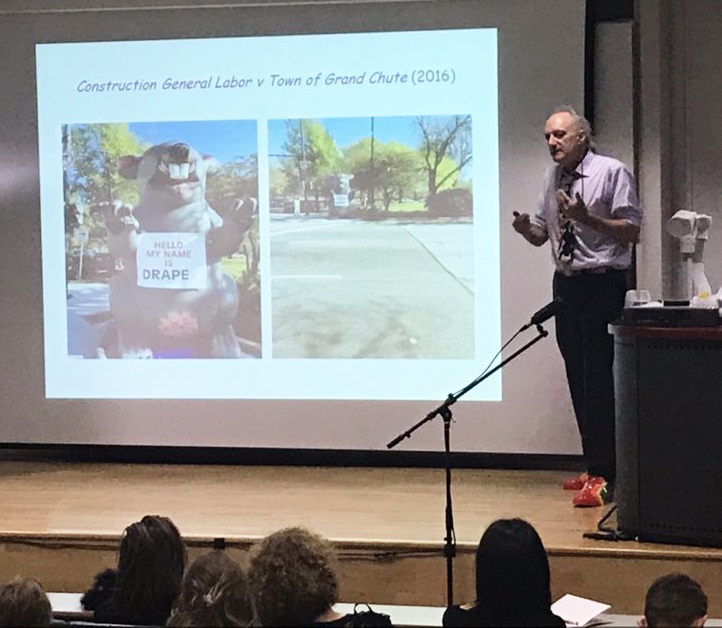On Thursday 2 May, the Department of Law welcomed Professor Peter Goodrich to give the department’s annual lecture on Retinal Justice: Rats, Maps, and Masks. Professor Goodrich is one of the co-founders of the School of Law at Birkbeck and in 2018 was elected an honorary fellow of the College.
Reader in Law and Political Theory, Dr Elena Loizidou and Professor of Law, Professor Adam Gearey reflected on the evening.

Dr Elena Loizidou: Images in the US are more and more an integral part of judicial judgement and moreover they produce what Professor Peter Goodrich calls an imago decidendi. In his lecture ‘Retinal Justice: Rats, Maps, and Mask’, Professor Peter Goodrich did not only guide us through ways of reading images in judgements, and called for the necessity of having an in court curator of images but gave us a lot to dream for. His powerful, enjoyable and humorous delivery facilitated even more the opening of the imagination.
I could not help, as somebody that is interested in seeing a social, legal and political transformation that at least undoes hierarchies, to imagine a time when judicial ‘pronouncements’ would be made of an assemblage of images that would be specific to the case that the court is handling. I could not stop myself of imagining that this has the potential of undermining the concept of the precedent and how this in turn may see the emergence of a system of adjudicating disagreements without the restrains of law, but emerging out of some other guidelines agreed by parties in dispute from case to case. One always lives in hope.
Professor Adam Gearey: Professor Peter Goodrich gave the Annual Law Lecture, ‘Retinal Justice: Rats, Maps, and Mask’. Professor Goodrich was one of the founders of the law school- and is presently an honorary fellow. There was certainly a sense of occasion, as alumni, students, staff and friends crowded into the basement lecture theatre. Peter Goodrich always gives a good show, and tonight was no different. One of the most interesting and important of contemporary legal philosophers, Professor Goodrich is also a fine performer. Sporting rainbow shoes, he paced the stage and banged on the projector screen for emphasis—a scholar and a dandy whose thinking exemplifies the rigour, intensity and playfulness that characterises thinking that is worth one’s attention.
Such a strange title! Professor Goodrich has long been interested in masks—his legal theory (hardly surprisingly) draws on ideas of drama and performance: the mask allows the actor to speak. It is an artifice or a convention that allows an audience to experience the drama as something ‘natural’. If masks allow actors to speak, then law allows subjects to speak by giving them a kind of structure or affiliation: man/woman/child – property owner; legatee, beneficiary, father, mother, citizen, criminal, holder of rights or duties etc. These features of law are ancient- and so- is the court’s concern with images. These are not just the images of law with which we are all familiar- but the way in which the law must adjudicate images. Professor Goodrich’s lecture primarily concerned images given in evidence; increasingly a central part of the court’s business. What conventions must the court invent to allow images to make sense forensically?
Hence ‘rats and maps’. The rat in question refers to an American case in which an image of a giant plastic rodent figured in the court’s reasoning. The maps evoked in the title are representations of title to land — evidence often lead in property disputes. Retinal justice- then- describes how the court seeks to do justice using images.
Professor Goodrich’s point is that the courts are incredibly bad at reading images– often using them to merely illustrate words- or- misreading them altogether. It may be that the modern technologies of images have outpaced law’s imaginary (the rhetorical and semantic techniques law uses to encode the world in its own terms). But there is something stranger at stake. Images point elsewhere- compromising techniques that set out to control them. Certainly, in some religious traditions, the image threatens the understanding of divine truth. Other traditions carefully guard licenced images and rituals. What if the disturbing effects of images were also at work in law; disturbing the ways in which it judges the world? Professor Goodrich’s point is that this most ancient of problems haunts modern law. To engage with law and images is to think critically about the ways in which law makes claims about its authority and validates its operations. The disturbances wrought by images provoke us to think about different kinds of adjudication, and perhaps to see different kinds of affiliation: different ways of being and living. Professor Goodrich is challenging students of the law to become more productive, more creative and playful—and, perhaps, as well as dressing better—to see things differently: retinal justice.